Jump rope exercises for weight loss are one of the most powerful yet underrated fitness techniques. This simple workout tool, often associated with children’s play, has now become a favorite among athletes, fitness trainers, and people who want to lose weight quickly and effectively. Unlike complicated gym equipment, a jump rope is budget-friendly, portable, and allows you to get a full-body workout in just a few minutes.
When it comes to burning calories, few workouts compare to jumping rope. A consistent jump rope routine can burn up to 600–1000 calories per hour, making it more effective than jogging, cycling, or many other cardio workouts. In addition, it improves cardiovascular health, builds stamina, and tones muscles across the body, especially the legs, core, and shoulders.
In this article, we will explore everything you need to know about jump rope exercises for weight loss, including what it is, why it works, the best time to do it, how it helps burn fat, eight effective tips to maximize results, common mistakes to avoid, FAQs, and a final conclusion to help you get started today.

What Are Jump Rope Exercises for Weight Loss ?
Jump rope exercises for weight loss refer to structured workouts using a skipping rope to burn calories and improve overall fitness. Unlike casual skipping, these exercises are carefully planned, focusing on speed, duration, and variations to maximize fat loss. By incorporating different jump styles and intervals, you can target various muscle groups while keeping the routine challenging and engaging.
These exercises are highly effective because they engage multiple muscles at the same time. Jump rope exercises for weight loss work your calves, thighs, arms, and core simultaneously, providing a full-body workout. This high level of engagement increases calorie burn, improves cardiovascular health, and strengthens muscles, making it a superior choice for those aiming to lose weight efficiently.
Consistency in jump rope exercises for weight loss helps build stamina and coordination over time. With a well-structured plan and proper form, you can achieve long-term fat loss, better endurance, and improved overall fitness while enjoying a fun and versatile workout routine.
Why Choose Jump Rope for Weight Loss ?
Jump rope exercises for weight loss are an effective and convenient way to burn calories quickly. This simple yet powerful workout engages multiple muscle groups, including legs, arms, and core, providing a full-body exercise that boosts metabolism. Unlike other workouts, jump rope exercises for weight loss can be done anywhere with minimal equipment, making it accessible for beginners and experienced fitness enthusiasts alike.
Another reason to choose jump rope exercises for weight loss is their ability to improve cardiovascular health. Regular skipping strengthens the heart, enhances blood circulation, and increases endurance. As you perform high-intensity intervals or continuous jumping, your body burns more fat in less time, supporting your weight loss goals efficiently and safely.
Jump rope exercises for weight loss also improve coordination, balance, and agility. With consistent practice, you’ll notice better stamina and overall fitness. When paired with a balanced diet, these exercises help achieve long-term fat loss and maintain a healthy, active lifestyle.
Other benefits include:
Portable and inexpensive equipment.
Suitable for beginners and advanced athletes.
Builds endurance and tones muscles simultaneously.
Helps reduce stress and improve mental clarity.
When Should You Do Jump Rope Exercises for Weight Loss ?
Jump rope exercises for weight loss can be done at various times of the day, depending on your schedule and energy levels. Many fitness experts suggest performing these exercises in the morning on an empty stomach to kickstart metabolism and burn fat more efficiently. Morning sessions can also energize you for the day ahead and help maintain consistency in your fitness routine.
For those who prefer afternoons or evenings, jump rope exercises for weight loss can serve as an excellent way to relieve stress and boost energy after work or daily chores. Pairing your session with a light snack, like a banana or yogurt, ensures you have enough energy to perform the exercises effectively without feeling sluggish.
It’s important to maintain a consistent schedule for jump rope exercises for weight loss. Aim for at least 15–30 minutes per session, 4–5 times a week. Consistency combined with a healthy diet maximizes fat-burning results and improves overall fitness.
Tips for timing:
Morning workouts → Boost energy and metabolism.
Afternoon or evening → Great for burning calories after meals.
Before strength training → Works as a warm-up to activate muscles.
How Does Jump Rope Help in Weight Loss ?
Jump rope exercises for weight loss work by raising your heart rate, increasing calorie burn, and improving overall metabolism. It is a high-intensity cardiovascular exercise, meaning your body continues to burn calories even after you finish due to the “afterburn effect” (EPOC – Excess Post-Exercise Oxygen Consumption).
The consistent movement also improves insulin sensitivity, balances hormones that regulate hunger, and promotes fat burning around stubborn areas like the belly, hips, and thighs.
Top Tips: Jump Rope Exercises for Weight Loss
Start with Basic Jumping

Jump rope exercises for weight loss begin with the foundation—simple two-foot jumps. This basic jump helps you build rhythm, coordination, and endurance without straining your muscles or joints. Beginners should spend at least 1–2 weeks practicing these jumps to master timing and technique, which reduces the risk of injury.
Starting with basic jumps allows your body to adapt to the continuous movement, warming up the calves, thighs, and core muscles. It also engages the arms slightly, enhancing overall calorie burn. By focusing on technique first, you establish a solid foundation that makes advanced jump rope variations more effective for weight loss.
To maximize benefits, pair your basic jump routine with proper nutrition. Foods rich in protein, such as eggs, lean meat, or plant-based alternatives, provide the muscles with necessary nutrients to recover and grow stronger. Including complex carbohydrates like oats and vegetables can fuel your workouts, making basic jumping more efficient for fat loss.
Benefits: Builds coordination, burns calories, strengthens lower body.
Gradually Increase Time and Intensity
For effective jump rope exercises for weight loss, gradually increasing the duration and intensity is crucial. Start with 2–3 minutes of continuous jumping and slowly build up to 15–30 minutes as endurance improves. This progressive approach prevents overtraining while allowing your cardiovascular system to adapt.
Increasing intensity also boosts calorie burn, turning your jump rope routine into a fat-loss powerhouse. Short intervals with brief rest breaks are ideal for beginners, while experienced individuals can add longer, continuous sessions to challenge endurance and stamina. Gradually extending workout times improves overall fitness while reducing body fat.
Supporting your exercise with proper nutrition enhances results. Incorporate anti-inflammatory foods like turmeric, berries, and nuts to help muscles recover faster, and maintain hydration with water or electrolyte drinks. These dietary “ingredients” improve energy levels and enhance the effectiveness of jump rope exercises for weight loss.
Benefits: Boosts stamina, increases calorie burn, enhances cardiovascular fitness.
Try High-Intensity Interval Training (HIIT)

High-intensity interval training (HIIT) is an advanced method for jump rope exercises for weight loss. Alternate between 30 seconds of fast, powerful jumps and 30 seconds of slow skipping or rest. This approach stimulates your metabolism and promotes fat burning even after the workout ends due to the afterburn effect.
HIIT targets multiple muscle groups, including calves, quads, glutes, core, and shoulders, increasing total body engagement. It also strengthens cardiovascular endurance and boosts overall energy expenditure. By including HIIT in your routine, you optimize calorie burn in a shorter amount of time compared to steady-state exercises.
For maximum results, pair HIIT sessions with a nutrient-rich diet. Focus on lean proteins like fish, chicken, or tofu to support muscle recovery, and include high-fiber vegetables to maintain satiety and prevent overeating. Combining these dietary elements with HIIT jump rope exercises for weight loss ensures faster, sustainable fat loss.
Benefits: Accelerates fat loss, improves endurance, enhances metabolism.
Mix Jump Rope Variations
Jump rope exercises for weight loss become more effective when you mix different variations. Incorporate single-leg jumps, crisscrosses, double unders, and side swings to engage multiple muscle groups and prevent workout monotony. These variations increase intensity and challenge your coordination, balance, and agility.
Using diverse jump styles targets muscles differently, promoting toning across calves, thighs, core, and shoulders. Double unders and crisscrosses, for example, demand more energy, increasing calorie burn. Switching up techniques prevents plateauing, ensuring continuous weight loss results.
Nutrition plays a key role in supporting advanced jump rope workouts. Include ingredients like bananas or oats pre-workout for energy, and post-workout, consume protein-rich foods for recovery. Combining proper nutrition with mixed jump rope exercises for weight loss ensures optimal muscle support, fat reduction, and overall health benefits.
Benefits: Prevents boredom, engages multiple muscles, boosts calorie burn.
Combine with Strength Training
For best results, combine jump rope exercises for weight loss with strength training. Performing push-ups, squats, or planks between jump rope intervals increases muscle tone and accelerates fat loss. This combination improves metabolism and enhances both aerobic and anaerobic fitness.
Strength training complements jump rope by building lean muscle mass, which burns more calories at rest. Integrating bodyweight exercises with skipping also strengthens the core, improves posture, and enhances joint stability, making workouts more effective and reducing injury risk.
Support your combined routine with nutrient-rich ingredients. Protein from eggs, legumes, or whey supports muscle repair, while healthy fats from avocados, nuts, and seeds improve energy and endurance. Proper hydration and balanced meals amplify the benefits of jump rope exercises for weight loss and overall strength.
Benefits: Builds muscle, accelerates fat burn, enhances metabolism.
Maintain Proper Form

Maintaining proper form is essential for jump rope exercises for weight loss. Keep elbows close to your body, wrists rotating the rope, and land softly on the balls of your feet. Proper posture reduces the risk of injury and ensures maximum calorie burn from each jump.
Correct form engages the right muscles efficiently, improving coordination, endurance, and joint stability. Landing softly prevents strain on knees and ankles, making jumping safe even for beginners. Wrist-controlled rope movement also reduces shoulder tension, making workouts more sustainable.
Supporting form with nutritional ingredients helps muscles stay strong and resilient. Include magnesium-rich foods like spinach, nuts, and seeds to reduce cramps and inflammation. Hydrating well ensures your muscles and joints perform optimally, making jump rope exercises for weight loss more productive and safe.
Benefits: Prevents injuries, enhances calorie burn, improves efficiency.
Stay Consistent and Track Progress
Consistency is key for any exercise, especially jump rope exercises for weight loss. Track your sessions, sets, and duration to monitor improvement over time. Maintaining a schedule ensures regular calorie burn and steady fat loss results.
Tracking progress motivates you to challenge yourself gradually, increasing intensity or incorporating variations over time. Consistency also reinforces cardiovascular improvements, strengthens muscles, and boosts coordination. Small incremental progress adds up to significant long-term results.
Support your routine with nutrition tracking. Log protein intake, hydration, and micronutrient-rich foods to ensure your body receives essential fuel. Ingredients like leafy greens, berries, and lean proteins complement consistent jump rope workouts for weight loss, enhancing energy, recovery, and performance.
Benefits: Promotes accountability, ensures progress, improves results.
Support with a Healthy Diet
Jump rope exercises for weight loss work best alongside a healthy, balanced diet. Proper nutrition fuels your body, supports muscle recovery, and accelerates fat burning. Focus on lean proteins, whole grains, fresh vegetables, and fruits to optimize energy and endurance during workouts.
Avoid processed foods, sugary drinks, and excessive fried foods, as they counteract the calorie-burning effects of jump rope exercises. Hydration is equally important—drink water before, during, and after sessions to maintain stamina and prevent cramps. Nutrient-rich ingredients like eggs, nuts, chia seeds, and spinach supply essential vitamins, minerals, and antioxidants to support recovery and weight loss.
By combining a healthy diet with consistent jump rope exercises for weight loss, you achieve the best results. Your body burns fat more efficiently, builds lean muscle, improves metabolism, and maintains overall health, creating a sustainable fitness routine for long-term success.
Benefits: Fuels workouts, improves recovery, accelerates fat loss.
Pros of Jump Rope Exercises for Weight Loss
Jump rope exercises for weight loss offer a highly effective way to burn calories quickly. By engaging multiple muscle groups simultaneously, including calves, thighs, arms, and core, these workouts maximize energy expenditure in a short period. This makes them ideal for those looking to lose weight efficiently while improving cardiovascular endurance. The fast-paced nature of jump rope routines also boosts metabolism, helping the body burn fat even after the workout is complete.
Another advantage of jump rope exercises for weight loss is their convenience and accessibility. All you need is a rope and a small space to jump. This allows workouts to be performed at home, in the gym, or even outdoors. The portability and minimal equipment make it easy to stick to a consistent routine, which is essential for sustainable weight loss.
Additionally, jump rope exercises for weight loss improve coordination, balance, and agility. Incorporating different jump variations challenges muscles in new ways, prevents workout monotony, and enhances overall physical fitness. Over time, consistent practic
Burns high calories in less time.
Improves cardiovascular endurance.
Strengthens muscles and tones body.
Portable and affordable equipment.
Works for both beginners and athletes.
Cons of Jump Rope Exercises for Weight Loss
Can cause joint strain if done with poor form.
Requires practice to maintain rhythm.
Not ideal for people with severe knee or ankle injuries.
A concise table for Jump Rope Exercises for Weight Loss:
| Aspect | Details | Benefits |
|---|---|---|
| Type | Skipping rope workouts | Burns calories, strengthens muscles |
| Muscles | Calves, thighs, arms, core | Full-body engagement |
| Duration | 5–30 mins per session | Fat loss, stamina boost |
| Variations | Single-leg, crisscross, double unders | Challenges muscles, prevents boredom |
| Support | Strength training + healthy diet | Enhances results, overall fitness |
Conclusion

Jump rope exercises for weight loss are among the most effective, affordable, and convenient ways to burn fat and improve fitness. Whether you are a beginner or an advanced athlete, incorporating skipping into your routine can help you burn calories, tone your muscles, and boost cardiovascular health.
Unlike many weight loss methods that require expensive gym memberships or complicated machines, jump rope offers a simple yet powerful workout solution that you can do anywhere. Consistency, proper form, and pairing it with a healthy diet will ensure long-term results.
So, if you are searching for a workout that is fun, efficient, and delivers fast results, jump rope exercises for weight loss are your best choice. Pick up your rope today and start skipping your way to a healthier, fitter, and leaner body.
FAQs
Q1. What are the best jump rope exercises for weight loss ?
The best exercises include basic jumps, double unders, side swings, single-leg jumps, and crisscross variations.
Q2. Why is jump rope effective for weight loss ?
It burns more calories than most cardio workouts, boosts metabolism, and engages multiple muscles at once.
Q3. When should I do jump rope for best results ?
Morning workouts are ideal to boost metabolism, but consistency matters more than timing.
Q4. How does jump rope compare to running for weight loss ?
Jump rope burns calories faster, is easier on joints when done correctly, and engages more muscles than running.
Q5. Can beginners do jump rope exercises for weight loss ?
Yes, beginners can start with 2–3 minutes daily and gradually increase intensity as stamina improves.

